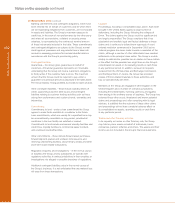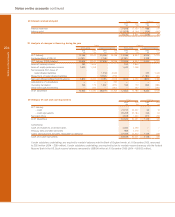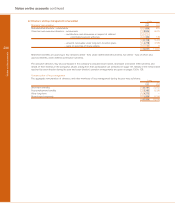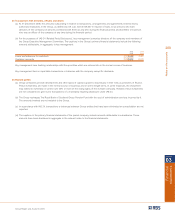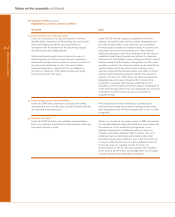RBS 2005 Annual Report Download - page 214
Download and view the complete annual report
Please find page 214 of the 2005 RBS annual report below. You can navigate through the pages in the report by either clicking on the pages listed below, or by using the keyword search tool below to find specific information within the annual report.
212
Notes on the accounts
UK GAAP
(n) Financial instruments: financial assets
Loans are measured at cost less provisions for bad and
doubtful debts, derivatives held-for-trading are carried at fair
value and hedging derivatives are accounted for in
accordance with the treatment of the item being hedged
(see Derivatives and hedging below).
Debt securities and equity shares intended for use on a
continuing basis in the Group’s activities are classified as
investment securities and are stated at cost less provision for
any permanent diminution in value. The cost of dated
investment securities is adjusted for the amortisation of
premiums or discounts. Other debt securities and equity
shares are carried at fair value.
(o) Financial instruments: financial liabilities
Under UK GAAP, short positions in securities and trading
derivatives are carried at fair value; all other financial liabilities
are recorded at amortised cost.
(p) Liabilities and equity
Under UK GAAP, all shares are classified as shareholders'
funds. An analysis of shareholders’ funds between equity and
non-equity interests is given.
IFRS
Under IAS 39, financial assets are classified into held-to-
maturity; available-for-sale; held-for-trading; designated as at
fair value through profit or loss; and loans and receivables.
Financial assets classified as held-to-maturity or as loans and
receivables are carried at amortised cost. Other financial
assets are measured at fair value. Changes in the fair value of
available-for-sale financial assets are reported in a separate
component of shareholders’ equity. Changes in the fair value of
financial assets held-for-trading or designated as at fair value
are taken to profit or loss. Financial assets can be classified as
held-to-maturity only if they have a fixed maturity and the
reporting entity has the positive intention and ability to hold to
maturity. Trading financial assets are held for the purpose of
selling in the near term. IFRS allows any financial asset to be
designated as at fair value through profit or loss on initial
recognition. Unquoted debt financial assets that are not
classified as held-to-maturity, held-for-trading or designated as
at fair value through profit or loss are categorised as loans and
receivables. All other financial assets are classified as
available-for-sale.
IAS 39 requires all financial liabilities to be measured at
amortised cost except those held-for-trading and those that
were designated as at fair value through profit or loss on initial
recognition.
There is no concept of non-equity shares in IFRS. Instruments
are classified between equity and liabilities in accordance with
the substance of the contractual arrangements. A non-
derivative instrument is classified as equity if it does not
include a contractual obligation either to deliver cash or to
exchange financial instruments with another entity under
potentially unfavourable conditions, and, if the instrument will
or may be settled by the issue of equity, settlement does not
involve the issue of a variable number of shares. On
implementation of IAS 32, non-equity shares with a balance
sheet value of £3,192 million and £2,568 million of non-equity
minority interests were reclassified as liabilities.
Notes on the accounts continued
Impementation of IAS 32, IAS 39 and IFRS 4
45 Transition to IFRS (continued)


